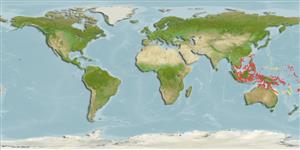>
Gobiiformes (Gobies) >
Gobiidae (Gobies) > Gobiinae
Etymology: Cryptocentrus: Greek, kryptos = hidden + Greek, kentron = sting (Ref. 45335).
More on author: Herre.
Environment: milieu / climate zone / depth range / distribution range
Ecologia
marinhas associadas(os) a recifes; intervalo de profundidade 1 - 25 m (Ref. 27115), usually 10 - 25 m (Ref. 48637). Tropical; 22°C - 28°C (Ref. 27115); 25°N - 24°S
Western Pacific: Yaeyama Islands, Japan to Singapore and the southern Great Barrier Reef; Palau and Truk in Micronesia.
Tamanho / Peso / Idade
Maturity: Lm ? range ? - ? cm
Max length : 10.0 cm SL macho/indeterminado; (Ref. 48637)
Descrição suscinta
Chaves de identificação | Morfologia | Morfometria
Espinhos dorsais (total) : 7; Raios dorsais (total) : 10; Espinhos anais: 1; Raios anais : 9. Predorsal scales absent. Occurs in two color phases, one yellow and the other with whitish ground color; both forms with 4-5 dusky bars (although faint in yellow fish) and fine pale blue or white spotting on head and anterodorsal part of body and fins. A dark brown streak above maxilla (Ref. 27362); further characterized by: brown snout; presence of thin brown line along edge of upper jaw; united pelvic fins, presence of frenum; longitudinal scale series 92-95; head without scales; greatest depth of body 4.4-4.6 in SL; rounded caudal fin, about equal to head length (Ref. 90102).
Inhabits sandy areas of shallow lagoons and protected coastal bays (Ref. 9710). Lives in a burrow with alpheid shrimps. Found in clear coastal sand slopes and lagoons, usually in depth of 10-25 meters (Ref. 48637).
Ciclo de vida ou comportamento de acasalamento
Maturidade | Reprodução | Desova | Ovos | Fecundidade | Larvas
Myers, R.F., 1991. Micronesian reef fishes. Second Ed. Coral Graphics, Barrigada, Guam. 298 p. (Ref. 1602)
Status na Lista Vermelha da UICN (Ref. 130435: Version 2024-1)
Ameaça para os humanos
Harmless
Uso pelos humanos
Pescarias: espécies comerciais; Aquário: Espécies comerciais
Ferramentas
Relatórios especiais
Baixar XML
Fontes da internet
Estimates based on models
Preferred temperature (Ref.
123201): 26.3 - 29.1, mean 28.4 °C (based on 502 cells).
Índice de diversidade filogenética (Ref.
82804): PD
50 = 0.5000 [Uniqueness, from 0.5 = low to 2.0 = high].
Bayesian length-weight: a=0.00724 (0.00339 - 0.01546), b=3.10 (2.92 - 3.28), in cm total length, based on LWR estimates for this (Sub)family-body shape (Ref.
93245).
Nível Trófico (Ref.
69278): 3.4 ±0.4 se; based on size and trophs of closest relatives
Resiliência (Ref.
120179): Elevada, tempo mínimo de duplicação da população menor que 15 meses (Preliminary K or Fecundity.).
Fishing Vulnerability (Ref.
59153): Low vulnerability (10 of 100).
Nutrients (Ref.
124155): Calcium = 134 [60, 254] mg/100g; Iron = 0.742 [0.383, 1.434] mg/100g; Protein = 17.9 [15.9, 19.7] %; Omega3 = 0.092 [0.040, 0.175] g/100g; Selenium = 23.5 [11.0, 52.1] μg/100g; VitaminA = 136 [36, 467] μg/100g; Zinc = 2 [1, 3] mg/100g (wet weight);
